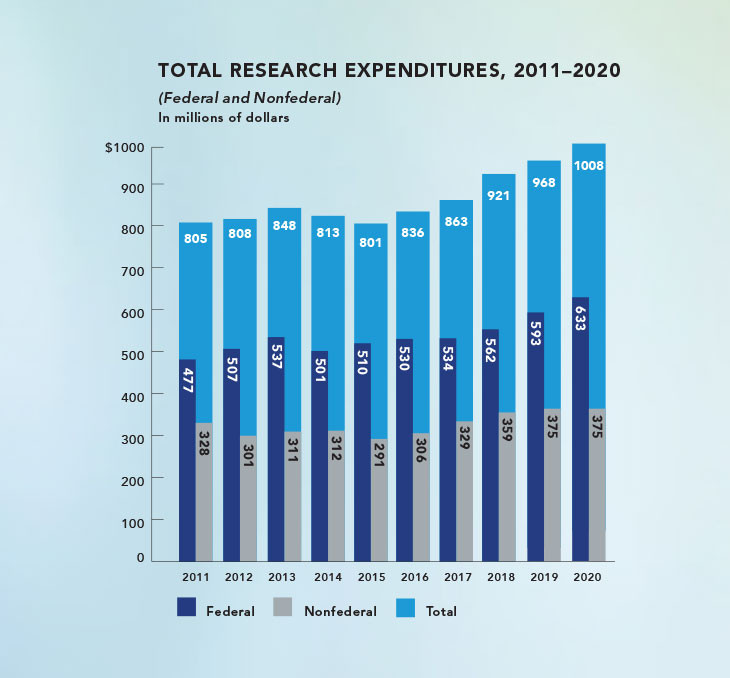
Penn State’s research expenditures exceeded the $1 billion mark in fiscal year 2019-20. The total figure, $1.01 billion, places Penn State among a select group of research universities nationally, and reflects the interdisciplinary strength built over three decades. It represents a $40 million increase over last year’s number, and includes a record $633 million in federal funding, as well as $375 million from a combination of private funders, the commonwealth of Pennsylvania and University sources.
“This milestone reflects both the strength of external support for the University’s research activity and the broad impact of that activity on solving complex societal problems,” said Penn State President Eric J. Barron. “From advancing health, to addressing food security and sustainable energy solutions, to contributing to economic development, Penn State’s research enterprise is dedicated to improving the overall quality of life for people in our communities, our nation and our world.”
“It’s a testament to the world-class quality and teamwork of our dedicated faculty, students and staff, and a statement of our continuing commitment,” said Senior Vice President for Research Lora Weiss. “These expenditures also reflect the continued confidence our sponsors have in us and the extensive breadth and depth of our research portfolio.” In the most recent NSF HERD (Higher Ed R&D) expenditures report, she noted, Penn State had 18 research fields ranked in the top 10, more than any other university.
Funding from federal agencies accounts for the entirety of the $40 million increase, with $35 million in additional funding coming from the Department of Defense, $9 million from the Department of Health and Human Services, and $3.5 million from the Department of Energy. Research funding from the commonwealth of Pennsylvania decreased from $73 million to $68 million, while funding from industry, foundations and other sponsors held steady at $101 million.
The largest single increase came from the Department of Defense, with a grant of $30 million to lead the Interaction of Ionizing Radiation with Matter University Research Alliance, focused on improving current and developing future warfighter technology to counter threats of destruction.
“We continue to value our long-standing partnership with the Department of Defense, and we are exceedingly proud of our ongoing role in defending the nation’s security,” said Weiss.
In recognizing the additional $9 million from DHHS, Weiss cited increased collaboration between researchers at University Park and those at Hershey Medical Center as an important factor. “These are connections and capacities that are growing every day,” she said.
Other notable examples of federally sponsored projects were a $4.9 million grant from the National Institutes of Health for testing a previously approved obesity drug for use in curbing opioid addiction and $3.5 million from the National Science Foundation to re-engineer and improve the functionality of Galaxy, a popular scientific data management system, designed to streamline solutions to complex, multidisciplinary scientific problems.
Non-federally funded projects included an effort funded by the Pennsylvania Fish and Boat Commission to restore the endangered Chesapeake Logperch in the Susquehanna River; a study of noise control in the urban office environment funded by an international supplier of hearing aids; and a grant from the Andrew W. Mellon Foundation to investigate transdisciplinary approaches to the performing arts.
The expenditures total includes research undertaken at all Penn State campuses across the commonwealth. Among academic research units that saw increased funding, the Applied Research Laboratory rose by $35 million, to a total of $309 million; the colleges of Engineering and Information Science and Technology both saw $4 million increases, to $153 million and $11 million, respectively; and the College of Health and Human Development rose by $3.5 million, to $54 million.
Weiss noted the added challenge this year of maintaining the continuity of a vast research enterprise while at the same time facilitating a rapid and wide-ranging response to a worldwide pandemic. Contingency steps included curtailing on-campus research activities in March while maintaining the limited access needed to continue essential research, and in May developing plans to gradually increase on-campus research activities and enable remote research.
“Our continued growth under challenging circumstances demonstrates our resilience and readiness to fulfill our land-grant mission, in Pennsylvania and around the globe,” Weiss said. Reaching this milestone, she added, “also speaks to the foresight and sustained hard work of my predecessors over the last three decades. Their vision and careful stewardship built the interdisciplinary culture, which we continue to build upon and innovate in the way we collaborate and do research every day.”